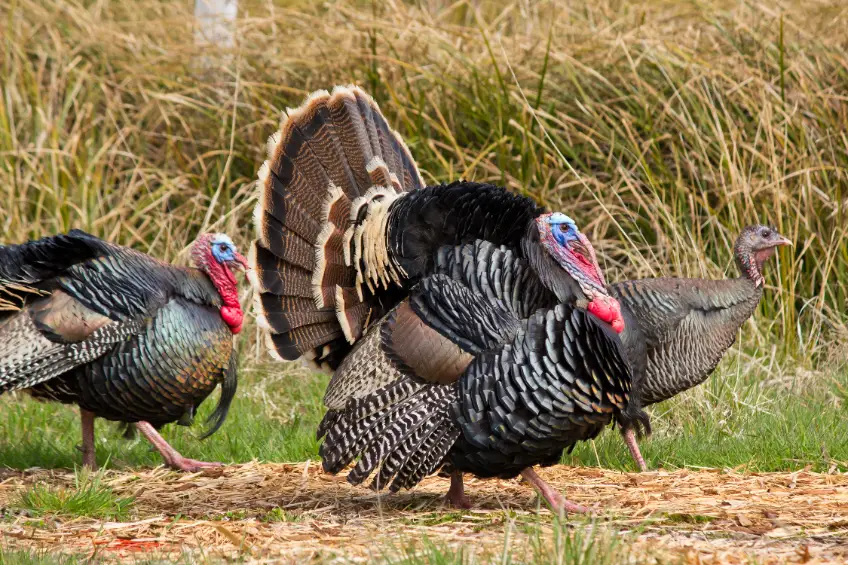
The west is home to a variety of Gould’s, Merriam’s, and Rio Grande wild turkeys. Among other places in the west, the Idahoan backcountry is an ideal habitat for Rio Grande turkeys. With some preparation and proper tactics, you can go bag a tom turkey this year.
By properly scouting, working in tandem with private landowners, and blending in when it comes time to hunt, you can greatly increase your odds of harvesting a turkey.
Let’s dive a little deeper into these areas.
(Pinetrees and solitude may earn a commission from affiliate links in this article.)
PATTERN YOUR PREY
Scouting the area a few days or weeks prior to the season opening can give you an advantage to tracking down a turkey. Look for signs like feathers, scat, and tracks. Keep in mind that the place that you found turkeys last year, might not be the place you find them this year. Also, consider that fall hunting for wild turkeys in the west can require covering more miles since it isn’t mating season— though one advantage to hunting them this time of year is that they are more predictable and keep to routines, if not disturbed. Starting out early is the perfect time to pattern their behavior. It’s also a great time to reach out to the game commissions in your respective areas to find out their data on turkey populations. Investing in tools like the mapping capabilities available with onX can also come in handy for mapping out where turkeys may be roosting and also any private land in the area.
Turkeys inhabit so many different types of environments from pine forests to river bottoms that they can adapt to many different areas. For example, turkeys camp out in the grass eating crab apples if they are around. This isn’t to say that turkeys are picky because these opportunistic omnivores are quick to gobble up grasshoppers, lizards, foliage, and snakes. So look out for some of these turkey staples in the area you are scouting.
GLASSING
A staple of scouting is glassing locations. Sometimes you will see turkeys on a private fields but notice that they will move into a pocket of nearby public land. It’s important to know where they will be available for you to set up on.
When glassing, keep in mind certain tendencies the turkeys have. Turkeys prefer going uphill because this allows them to scope the area out while keeping their bodies protected. After settling into a good vantage point, try using a locator call that carries even on windy days since it draws turkeys out.
The most important thing about scouting out western wild turkeys is to not get too close— getting caught early on can have turkeys on high alert and they’ll quickly learn to avoid you. Using a spotting scope or binoculars in this situation can be invaluable to the success of your hunt.
MAKE FRIENDS
Hunting western turkeys can pose some challenges when hunting on public land. Some of these obstacles can include people using recreational vehicles and playing loud music while driving with the windows down in their truck. A way to avoid this is by making friends with landowners and helping keep the turkey population down for them. It’s a win-win situation for many farmers and avoids turkeys being spooked off by other people. You can utilize onX to find the names of landowners and try and contact them.
Another thing to consider is to be mindful of your state’s hunting hours and regulations when you proceed into the season. Making friends with local fish and wildlife employees can also pave the way to getting possible tips of where turkeys are located— and it never hurts to stick to the laws.
BLEND IN
Setting up a blind is a great way to lure turkeys into the area, but it’s important that everything is camouflaged—including your gun or bow. Also, don’t ever wear red, blue, or white when hunting turkeys since these colors are dead giveaways to turkeys and are colors that males are looking out for. When hunting this way, it’s usually better not to stalk western turkeys, but read the situation in these instances because it can dictate if you should bump and separate, and then time your yelps to draw the stray in or stay still and be patient while using a call to lure the longbeard by sounding like an irresistible hen.
If you prefer to not be tied down to one place, then many turkey hunters also opt for using a turkey vest with a nice but pad. They are real handy for moving around and carrying a nice seat with you also.
Another thing to consider is the western wild turkey’s habitat. In the colder months many prefer roosting in the ponderosa pine, though Merriam’s in particular, may gather in the pinyon pine-oak. When the snow begins to melt wild turkeys will follow the snowline into mating season. Prepare to hear a lot of gobbling during this time as toms start working on their harem. After mating season is over and the hen’s nest in denser foliage, to later spend the summer eating insects until the weather once again begins to cool. In the fall wild turkeys will feast on juniper berries, pinyon seeds, and oak nuts, until the start of winter. These are all good places to look out for longbeards.
SPEAK THEIR LANGUAGE
Western turkeys are not easily fooled, and they’re picky males who probably won’t come to a novice hunter blaring out an unconvincing hen call. But for an experienced hunter who knows what they’re doing, this is also the perfect opportunity to lure toms their way. With western turkeys living in pockets on large acres of land, these big guys will search miles for hens. This way they’ll be calling out often and make a long trek just to gain a hen—this is the perfect time to flex your call skills and attract them towards your location.
Another point about calls, when hunting western turkeys is that the time of year matters. Mating season runs from late April through May, and this changes the kinds of calls and tactics you’d want to use when luring a tom in. Early in the season, it’s good to play a little coy and hard to get— let the longbeards come to you. Notice how other hens are calling to gain a longbeard’s attention and mimic them when calling as well to help ensure that the tom will find you irresistible and come to investigate. Yet, this tactic may not work later in the season when toms are henned-up. If this occurs using a gobbler call may bring a tom in, or possibly, the whole flock. In this instance a decoy will probably come in handy to give the tom something to approach.
An alternative tactic for spring turkey hunting is to position yourself near a known roosting area at the end of the day and utilize the yelp call to get a longbeards attention. If one gobbles back, then you can use a few more enthusiastic cuts and then go silent to entice the tom in. Either way this tactic gives an advantage, because either the tom will be tempted right then and there, or he’ll fly-up to roost and you know where to hit the next morning. Though one caveat of calls— don’t call turkeys in trees, because it’s more likely they’ll spot you and can spook.
In the fall, calling tactics should shift; now, consider louder as better if birds aren’t close. There’s a lot of land to cover when hunting in the west so attracting a tom is going to take more calls and louder calls. Be sure to yelp, purr, and cluck like the dirty bird you are. However, if your calls go unanswered it’s not because you aren’t a pretty enough hen, keep trying, but do something different; swiftly reposition yourself ahead of the longbeard’s path and try again. Also, it’s okay to be forward in this case because sometimes toms can’t resist a sweet-sounding hen. Cadence can also play a part in this; so, if calls aren’t getting any reaction try changing the rhythm of the calls because it may make all the difference.
Fall can be a bit more precarious when locating birds since they are not flocking together the way they do in the spring. If it’s been difficult to locate any sign of turkeys in the area, driving around or walking around areas early in the morning where you suspect wild turkeys might be, while using a coyote or peacock call, might be your best bet. Around every half mile use one of these calls to see if it may kick up some birds.
These tactics can help bring in a nice turkey this season. Happy hunting! If you enjoyed this article, check out these others on turkey hunting.
What Do I Need For Turkey Hunting Out West
Where To Find Turkeys: Tips For This Season
(This article was originally published on Pintreesandsolitude.com. If it is now published on any other site, it was done without permission from the copyright owner.)
